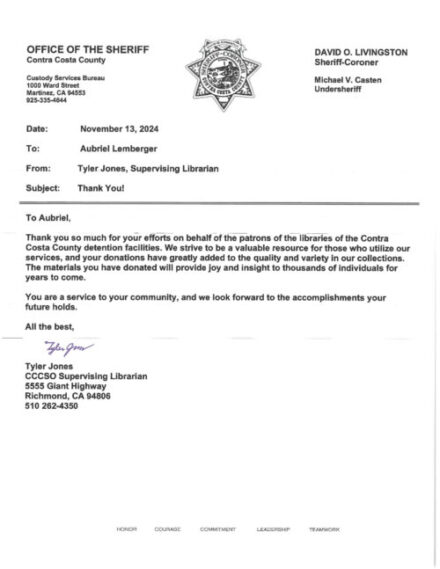Education, Drug Treatment, and Rehabilitation
Within the Carceral System
This website is dedicated to all of those who live—or have lived in the past—inside the walls of a jail or prison.
—Aubrey Lemberger
author and advocate
Oakland California


The books that we collect are made available to men and women incarcerated at the West County Detention Facility in Richmond, California.
To donate books please contact us at:
![]()
Thank you for your support.
The West County Detention Facility offers innovative and essential programs to inmates. When I learned that this jail welcomes book donations, I saw this as a way in which we as a community could make a contribution. So I decided to build a book drive, where all of the books would go straight to the facility’s library and classrooms… (click here for more information about this project)
I have received this letter from Tyler Jones, the librarian at the West County Detention Facility, in appreciation of our donation of books:


Inmates in Class at the California Rehabilitation Center, Norco CA
Introduction
Incarceration is a word that means confinement and cancellation of one’s freedom in a prison or jail. There are many reasons why a person may be put behind bars—reasons that are often over-simplified and based on misunderstandings when those incarcerated are distanced by a narrow lens that excludes compassion. The American carceral system uses punishment to deter crime, claiming that those who have committed crimes lack self discipline or some other virtue. But if we look more deeply, we will find that first-time incarceration, and then recidivism back to prison or jail, may be caused in large part by the penal system itself, specifically its failure to offer a pathway to rehabilitation.
When reflecting on the main purpose of the American carceral system as it exists today, without hesitation, the first aim that is often pronounced is “punishment.” Words such as “deterrence” come up too, but the word “rehabilitation” is more than likely last on the list. The fact that rehabilitation is ranked so low among the aims of the American carceral system is without a doubt the most telling sign of its inhumane character.
Shouldn’t rehabilitation be the main goal of prisons and jails, so that those inside the walls of these institutions can have the greatest chance of living a successful, law-abiding life? This strikes me as clearly the case, and is even more obvious when we take into account that 60-70% of those incarcerated in my home state of California have been convicted because of some connection to addictive drugs. Substance abuse is a treatable condition.
The story of my own involvement with all of this is the following: I first found out about mass incarceration in school, and then set out to get more information about prison rehabilitation from those who work in a local jail here in the San Francisco Bay Area. I’ve also read, studied, and reflected on the history and philosophy of incarceration. I’ve learned a lot, and would like to share my research with you, so that we can all evaluate the importance of prison rehabilitation. This website is a common ground that I’ve created, and I’m glad that you’ve joined me here. We can walk this path together.
Education and Incarceration
A hunger for learning belongs to human at all stages of life. For those incarcerated, no less than for anyone else, education is essential to finding one’s path forward. Prison education programs come in many forms, and the state of California stands at the forefront of developing them, ranging from individual classes that impart basic practical skills to full degree-granting programs. It is widely recognized today that the use by inmates of educational resources paves the way to increased employment opportunities post-release, and to lower rates of recidivism (return to incarceration).
Although rates of incarceration in California are very high for people of color, jails and prisons in this state offer more resources and support than do most prisons across the country. This is, paradoxically, in part due to the prison overcrowding problem in the 1990’s which resulted from Governor Reagan’s closure of California mental health institutions, leading to higher incarceration rates and forcing California prisons to accommodate the larger numbers.
For more on the subject of education, click here.
Re-Entry
The process of leaving incarceration can be as complicated as the life situation that originally led to time behind bars! Nicole Green is a social worker at Richmond CA’s West County Detention Facility who helps inmates transition back into society. She begins working with them many months before their release date, to properly assess what their circumstances will be when they re-enter their community, and what support they might need.
California law mandates that inmates have 48 to 72 hours to get in contact with their probation officers upon release from custody, and if they fail to do this they could be sent back to jail. The purpose of this communication is to assure law enforcement that this person does not return to crime. But so much more than that is needed. What the jail system often fails to do is to communicate to inmates the range of their re-entry support options. Green states that “there are some people that are getting out and are going into the same toxic environment that put them in jail in the first place.” She emphasizes that the most effective method of reducing recidivism is simply an inmate’s learning and providing wrap-around services that are needed for each person to have the highest chance at success upon release.
For more on the subject of re-entry click here.
